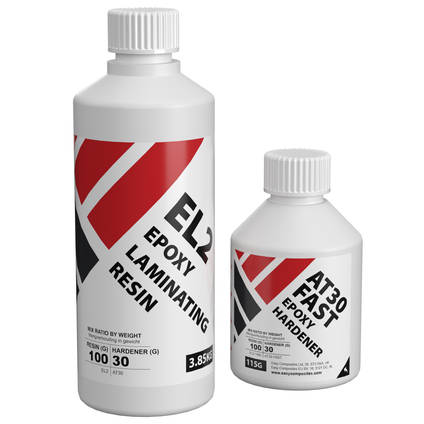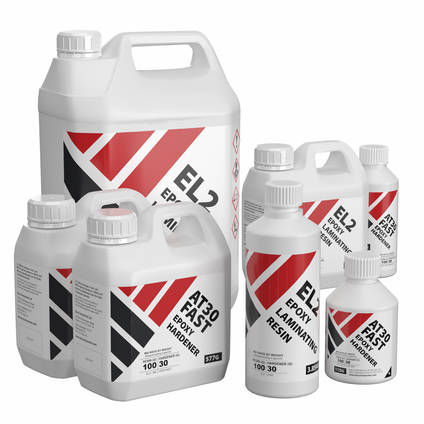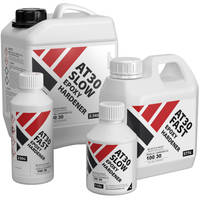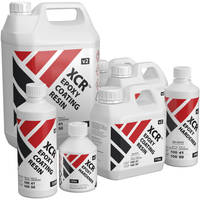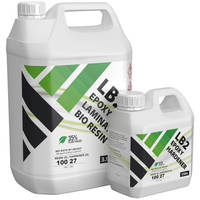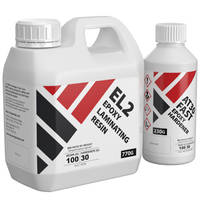Heb je hulp of advies nodig?+44 (0)1782 454499
Downloads (3)
Dit is een chemisch product. Voor opslag of gebruik moet u de bijgevoegde veiligheids- en technische informatiebladen downloaden en lezen.
| Veiligheidsinformatieblad (SDS) - NL | ||
| Veiligheidsinformatieblad (SDS) - NL | ||
| Technisch gegevensblad (TDS) |
Specificatie
Geharde Echanische Eigenschappen
| Max. Onderhoudstemperatuur | 83 | °C |
|---|---|---|
| Druksterkte | 88 - 98 | MPa |
| Hardheid | 87 (Hard) | Kust D |
| Flexibiliteit | Hard/stijf | |
| Treksterkte | 67 - 75 | MPa |
| Buigsterkte | 120 - 130 | MPa |
| Buigmodulus | 3.6 - 4.0 | GPa |
| Rek bij Breuk | 6.0 - 8.0 | % |
| Tg Begin (DMA) | 70 - 76 | °C |
Productgegevens
| Kleur | Duidelijk | |
|---|---|---|
| Chemie / Materiaal | Epoxy | |
| Viscositeit | 1200 | mPa.s |
| UV-bestendigheid | Zeer goed | |
| Merk | Easy Composites | |
| Houdbaarheid | 12 | Maanden |
Levensduur Pot en Uithardingstijden
| Levensduur Pot (Normaal) | 14 | minuten |
|---|---|---|
| Initiële Uithardingstijd | 5 | Uur |
Algemene Eigenschappen
| Brutogewicht | 0.576 | kg |
|---|
Verzendinformatie
Beperkingen
Dit product is geclassificeerd als gevaarlijke goederen voor transport.
Het kan worden verzonden naar alle landen op het vasteland van de EU, Ierland, de Balearen, Corsica, Sicilië en Sardinië.
Helaas kunnen we op dit moment geen gevaarlijke goederen verzenden naar Cyprus, Malta, de Canarische Eilanden, Ceuta, Melilla, Jan Mayan en Spitsbergen.
Zie onze pagina met leveringsinformatie voor volledige informatie over de verzending van gevaarlijke goederen.
Verpakkingsgrootte
Er zijn geen beperkingen op de pakketgrootte of toeslagen voor dit product.
Verzendkosten
Om de bezorgkosten van dit artikel naar uw adres te achterhalen, voegt u het toe aan uw winkelwagen en gebruikt u vervolgens de directe verzendkosten calculator op de winkelwagenpagina.
EL2 Epoxy Lamineerhars
- EP-L2-F-05
Gevaarlijk
- 5/5 Gemiddelde beoordeling
EL2 is een hoogwaardig epoxy lamineerhars dat geschikt is voor het met de hand opbrengen van versterkingen zoals koolstofvezel, aramide en glasvezel. De combinatie van mechanische prestaties, snelle wet-out, eenvoudige verwerking en goede prijs maken EL2 een enorm populaire keuze in de motorsport, botenbouw, modelbouw en algemene composieten.
Verkocht als kit (hars en verharder). Online te koop met een keuze uit FAST of SLOW verharder in 500g, 1kg en 5kg kits.
PRODUCTVERSIES
Kit Maat
Snelheid
BESCHIKBAARHEID:Meer dan 10 beschikbaarvoor onmiddellijke verzending
We zijn niet te verslaan op prijs!
Als u denkt dat u elders een gelijkwaardig product goedkoper kunt kopen, neem dan contact met ons op om uw wensen te bespreken.
Hoogwaardige epoxy lamineerhars voor algemeen gebruik voor het nat leggen of vacuümzakken van koolstofvezel-, Kevlar of glasvezellaminering.
Deze epoxy met lage viscositeit vertoont uitstekende bevochtigingseigenschappen, vooral bij gebruik als epoxyhars voor koolstofvezel- en aramidevezelversterkingKevlar), waardoor luchtbellen in het laminaat minder waarschijnlijk zijn dan bij sommige alternatieve epoxysystemen.
De hars vertoont ook uitstekende uitgeharde mechanische eigenschappen die veel beter zijn dan die van veel meer traditionele epoxyharsen (zoals te zien is op de technische informatiebladen). Verbeterde mechanische eigenschappen betekenen sterkere, lichtere en beter presterende onderdelen.
In alle maten wordt de epoxy verkocht als een verpakking, wat betekent dat deze de hars en de juiste hoeveelheid verharder bevat.
SNELLE en TRAGE verharders
EL2 is verkrijgbaar met een keuze uit twee verhardingssnelheden: 'FAST' met een pot-life van 12-17 minuten en ontvormbaar in ongeveer 8 uur en 'SLOW' met een pot-life van 95-115 minuten en ontvormbaar in ongeveer 30 uur.
Naast de opties van FAST of SLOW verharder, hebben we onlangs de optie toegevoegd om de verharders te splitsen en half FAST en half SLOW op de verpakkingen van 1kg en 5kg te hebben. Als u hiervoor kiest, worden de verharders geleverd als één verpakking FAST en één verpakking SLOW in de juiste verhouding tot de harsset.
Helaas kunnen we geen gemengde verhardersnelheden aanbieden op de 500g kitformaten.
FAST en SLOW verharders kunnen gemengd worden om pot-life en ontvormtijden te verkrijgen die overal tussen de specificaties liggen. Je moet echter nog steeds de juiste verhouding hars/verharder aanhouden voor een goede uitharding.
Typisch Gebruik
Te gebruiken als lamineer epoxyhars voor algemeen gebruik voor het natlijmen of vacuümzakken van composieten zoals glasvezel, koolstofvezel en aramidevezelKevlar).
Na uitharding vertoont de epoxy uitstekende mechanische eigenschappen waardoor het geschikt is voor het lamineren van structurele onderdelen. Het hars vertoont ook een uitstekende helderheid waardoor het ook geschikt is voor gebruik bij het lamineren van ongeverfde (of gepigmenteerde) koolstofvezelcomposieten.
We hebben ook een biologische versie van onze lamineerhars die de inhoud op basis van fossiele brandstoffen vervangt door een biologisch alternatief. Je vindt het hier: LB2 Epoxy lamineerhars Bio
Verdere informatie
Lamineerkit Top-Ups
Dit is de hars die wordt gebruikt in onze Carbon Fibre Laminating Starter Kit. Als je je eigen grotere versie van een van onze kits wilt maken, dan is dit de hars die je nodig hebt.
Compatibiliteitsinformatie - Wat Wel en Niet Moet Doen
Hoewel dit zeker geen volledige lijst is, zijn de onderstaande matrijsmaterialen, pigmenten en additieven allemaal getest en staan ze bekend om hun goede werking met EL2.
Compatibele mallen
- Uni-Mould systeem
- Epoxy Tooling Gelcoat
- Mallen op basis van epoxygelcoat
- Polypropyleen en polyethyleen plaat
- Aluminium
- Gehard glas (bijv. productie van vlakke platen)
Compatibele Pigmenten
- Epoxy kleurpigment * (voor levendige dekkende kleuren)
- Doorschijnend kleurpigment * (voor minder levendige dekkende kleuren)
Compatibele vulstoffen
- Alle droge vulpoeders
* Bij felgekleurde laminaten zoals koolstofvezel kan de onderliggende kleur van de stof nog steeds door de gepigmenteerde hars heen komen, vooral bij dunnere lagen hars over het onderliggende laminaat.
Belangrijke Verwerkingsinformatie
- Gebruiksgemak: Geschikt voor professioneel en hobbygebruik (volg het veiligheidsinformatieblad).
- Geur: EL2 is bijna reukloos.
- Veiligheidsmaatregelen: Draag handschoenen en een veiligheidsbril en werk in een goed geventileerde ruimte. Lees voor gebruik altijd het veiligheidsinformatieblad (MSDS).
- Omgevingsomstandigheden: Kan gebruikt worden van 15 tot 30°C, hoewel de pot-life en uithardingstijd aanzienlijk beïnvloed worden. Aanbevolen bij een omgevingstemperatuur van 20-25°C.
- Ontgassen: In de meeste gevallen niet nodig. Gewoon mengen en gebruiken.
- Mengverhouding: Meng 'Hars' en 'AT30 Verharder' 100:30 in gewicht. Gebruik een digitale weegschaal.
- Mengen: Meng grondig met de hand gedurende ongeveer 2 minuten.
- Potleven: SNELLE VERHARDING 12-17 minuten. TRAGE uitharder 95-115 minuten. Gebruik je hars vóór deze tijd.
- Exotherm (oververhitting): Hars wordt warm terwijl het uithardt. Meng in kleine batches en gebruik snel. Gemengde hars in een pot raakt snel oververhit (exotherm) en kan gaan roken/ontbranden. Laat gemengde hars nooit onbeheerd achter.
- Uithardingstijd/uitvloeiing: Bij 25°C kun je een typische uithardingstijd verwachten van 4-6 uur voor de FAST & 20-30 uur voor de SLOW AT30 verharders.
- Pigmenten en vulstoffen: Een breed scala aan pigmenten en vulstoffen kan worden toegevoegd om de eigenschappen en het uiterlijk van hars te veranderen.
Hoogwaardige epoxy lamineerhars voor algemeen gebruik voor het nat leggen of vacuümzakken van koolstofvezel-, Kevlar of glasvezellaminering.
Deze epoxy met lage viscositeit vertoont uitstekende bevochtigingseigenschappen, vooral bij gebruik als epoxyhars voor koolstofvezel- en aramidevezelversterkingKevlar), waardoor luchtbellen in het laminaat minder waarschijnlijk zijn dan bij sommige alternatieve epoxysystemen.
De hars vertoont ook uitstekende uitgeharde mechanische eigenschappen die veel beter zijn dan die van veel meer traditionele epoxyharsen (zoals te zien is op de technische informatiebladen). Verbeterde mechanische eigenschappen betekenen sterkere, lichtere en beter presterende onderdelen.
In alle maten wordt de epoxy verkocht als een verpakking, wat betekent dat deze de hars en de juiste hoeveelheid verharder bevat.
SNELLE en TRAGE verharders
EL2 is verkrijgbaar met een keuze uit twee verhardingssnelheden: 'FAST' met een pot-life van 12-17 minuten en ontvormbaar in ongeveer 8 uur en 'SLOW' met een pot-life van 95-115 minuten en ontvormbaar in ongeveer 30 uur.
Naast de opties van FAST of SLOW verharder, hebben we onlangs de optie toegevoegd om de verharders te splitsen en half FAST en half SLOW op de verpakkingen van 1kg en 5kg te hebben. Als u hiervoor kiest, worden de verharders geleverd als één verpakking FAST en één verpakking SLOW in de juiste verhouding tot de harsset.
Helaas kunnen we geen gemengde verhardersnelheden aanbieden op de 500g kitformaten.
FAST en SLOW verharders kunnen gemengd worden om pot-life en ontvormtijden te verkrijgen die overal tussen de specificaties liggen. Je moet echter nog steeds de juiste verhouding hars/verharder aanhouden voor een goede uitharding.
Typisch Gebruik
Te gebruiken als lamineer epoxyhars voor algemeen gebruik voor het natlijmen of vacuümzakken van composieten zoals glasvezel, koolstofvezel en aramidevezelKevlar).
Na uitharding vertoont de epoxy uitstekende mechanische eigenschappen waardoor het geschikt is voor het lamineren van structurele onderdelen. Het hars vertoont ook een uitstekende helderheid waardoor het ook geschikt is voor gebruik bij het lamineren van ongeverfde (of gepigmenteerde) koolstofvezelcomposieten.
We hebben ook een biologische versie van onze lamineerhars die de inhoud op basis van fossiele brandstoffen vervangt door een biologisch alternatief. Je vindt het hier: LB2 Epoxy lamineerhars Bio
Verdere informatie
Lamineerkit Top-Ups
Dit is de hars die wordt gebruikt in onze Carbon Fibre Laminating Starter Kit. Als je je eigen grotere versie van een van onze kits wilt maken, dan is dit de hars die je nodig hebt.
Compatibiliteitsinformatie - Wat Wel en Niet Moet Doen
Hoewel dit zeker geen volledige lijst is, zijn de onderstaande matrijsmaterialen, pigmenten en additieven allemaal getest en staan ze bekend om hun goede werking met EL2.
Compatibele mallen
- Uni-Mould systeem
- Epoxy Tooling Gelcoat
- Mallen op basis van epoxygelcoat
- Polypropyleen en polyethyleen plaat
- Aluminium
- Gehard glas (bijv. productie van vlakke platen)
Compatibele Pigmenten
- Epoxy kleurpigment * (voor levendige dekkende kleuren)
- Doorschijnend kleurpigment * (voor minder levendige dekkende kleuren)
Compatibele vulstoffen
- Alle droge vulpoeders
* Bij felgekleurde laminaten zoals koolstofvezel kan de onderliggende kleur van de stof nog steeds door de gepigmenteerde hars heen komen, vooral bij dunnere lagen hars over het onderliggende laminaat.
Belangrijke Verwerkingsinformatie
- Gebruiksgemak: Geschikt voor professioneel en hobbygebruik (volg het veiligheidsinformatieblad).
- Geur: EL2 is bijna reukloos.
- Veiligheidsmaatregelen: Draag handschoenen en een veiligheidsbril en werk in een goed geventileerde ruimte. Lees voor gebruik altijd het veiligheidsinformatieblad (MSDS).
- Omgevingsomstandigheden: Kan gebruikt worden van 15 tot 30°C, hoewel de pot-life en uithardingstijd aanzienlijk beïnvloed worden. Aanbevolen bij een omgevingstemperatuur van 20-25°C.
- Ontgassen: In de meeste gevallen niet nodig. Gewoon mengen en gebruiken.
- Mengverhouding: Meng 'Hars' en 'AT30 Verharder' 100:30 in gewicht. Gebruik een digitale weegschaal.
- Mengen: Meng grondig met de hand gedurende ongeveer 2 minuten.
- Potleven: SNELLE VERHARDING 12-17 minuten. TRAGE uitharder 95-115 minuten. Gebruik je hars vóór deze tijd.
- Exotherm (oververhitting): Hars wordt warm terwijl het uithardt. Meng in kleine batches en gebruik snel. Gemengde hars in een pot raakt snel oververhit (exotherm) en kan gaan roken/ontbranden. Laat gemengde hars nooit onbeheerd achter.
- Uithardingstijd/uitvloeiing: Bij 25°C kun je een typische uithardingstijd verwachten van 4-6 uur voor de FAST & 20-30 uur voor de SLOW AT30 verharders.
- Pigmenten en vulstoffen: Een breed scala aan pigmenten en vulstoffen kan worden toegevoegd om de eigenschappen en het uiterlijk van hars te veranderen.
Specificatie
Geharde Echanische Eigenschappen
| Max. Onderhoudstemperatuur | 83 | °C |
|---|---|---|
| Druksterkte | 88 - 98 | MPa |
| Hardheid | 87 (Hard) | Kust D |
| Flexibiliteit | Hard/stijf | |
| Treksterkte | 67 - 75 | MPa |
| Buigsterkte | 120 - 130 | MPa |
| Buigmodulus | 3.6 - 4.0 | GPa |
| Rek bij Breuk | 6.0 - 8.0 | % |
| Tg Begin (DMA) | 70 - 76 | °C |
Productgegevens
| Kleur | Duidelijk | |
|---|---|---|
| Chemie / Materiaal | Epoxy | |
| Viscositeit | 1200 | mPa.s |
| UV-bestendigheid | Zeer goed | |
| Merk | Easy Composites | |
| Houdbaarheid | 12 | Maanden |
Levensduur Pot en Uithardingstijden
| Levensduur Pot (Normaal) | 14 | minuten |
|---|---|---|
| Initiële Uithardingstijd | 5 | Uur |
Algemene Eigenschappen
| Brutogewicht | 0.576 | kg |
|---|
Niet-uitgeharde harsen worden geclassificeerd als gevaarlijke goederen en moeten op de juiste manier worden afgevoerd. Voor huishoudelijke gebruikers heeft het plaatselijke recyclingcentrum meestal een afvalverwijderingsdienst voor dergelijke chemicaliën of containers.
Omdat uitgeharde harsen inert zijn en veilig kunnen worden weggegooid, is het vaak het makkelijkst om onnodige of verouderde hars en verharder samen te mengen om ze uit te harden. Eenmaal uitgehard kunnen ze met het gewone afval worden weggegooid.
In tegenstelling tot andere harssystemen zoals polyester of vinylester, is het bij epoxy heel belangrijk om de mengverhoudingen nauwkeurig te krijgen. Als je de mengverhouding een klein beetje verkeerd hebt (laten we zeggen een paar gram op een kleine mix) dan zal de hars nog steeds uitharden, maar de mechanische eigenschappen zullen niet zo goed zijn als ze zouden zijn geweest als de mengverhouding precies goed was geweest. Als je er echter meer dan een paar gram naast zou zitten, dan zou je kunnen merken dat de hars niet goed hard is als hij is uitgehard en/of dat de afwerking plakkerig is. Dit zou resulteren in een veel zwakkere reparatie en moet worden vermeden door zorgvuldig te meten.
Nee, we zouden geen epoxyharsen aanraden voor de bekleding van een brandstoftank. Over het algemeen zijn epoxies goed bestand tegen benzine en veel van de chemicaliën en additieven die in pompbrandstof worden aangetroffen. Het is echter bekend dat ethanol in brandstof na verloop van tijd problemen kan veroorzaken en daarom moeten in plaats daarvan gespecialiseerde harsen voor tankbekleding worden gebruikt (vaak op basis van novalac vinylester). Een dergelijk product is GTS 1750 dat wordt verkocht door Caswell Europa.
Nee, deze epoxy tast net als andere epoxies geëxpandeerd polystyreen niet aan.
We hebben geen specifieke FDA (of vergelijkbare) goedkeuring voor dit harssysteem gekregen, dus als je deze platen commercieel zou willen maken, dan zou je of een plaat moeten maken met dit harssysteem en het vervolgens moeten laten testen en goedkeuren dat het veilig is voor gebruik in levensmiddelen, of een ander harssysteem moeten gebruiken dat specifiek is goedgekeurd voor gebruik in levensmiddelen. Gemengd en volledig en goed uitgehard zou het resulterende plastic stabiel en niet-toxisch moeten zijn, maar er zouden testen nodig zijn om dit te bewijzen. Wat betreft de vaatwasmachinebestendigheid: een vaatwasmachine is een zeer agressieve omgeving (schurend, hoge temperaturen, bijtend) en dus denk ik dat het voor elk harssysteem behoorlijk moeilijk zou zijn. Voer gerust je eigen tests uit, maar ik zou sterk aanraden om een koolstofvezelplaat niet als 'vaatwasmachinebestendig' op de markt te brengen.
Boven de HDT van een harssysteem zal het iets zachter worden en zullen de mechanische eigenschappen beginnen af te nemen, maar een thermohardende kunststof (zoals epoxy) is GEEN thermovormbare kunststof, dus het zal niet weer zodanig gaan vloeien dat je het uit je onderdeel zou kunnen smelten. Het zal eerder een beetje zacht worden en dan mogelijk weer brozer voordat het uiteindelijk gaat branden als je de temperatuur te hoog maakt. Het lijkt mij dat je een thermovormbare kunststof (ook wel thermoplast genoemd) nodig hebt met een relatief laag smeltpunt. Ik zou iets als PCL voorstellen.
Een post-cure bij verhoogde temperatuur is niet vereist voor onderdelen gemaakt met epoxyhars, maar post-curing verbetert de mechanische eigenschappen van de hars (en dus het onderdeel) en als je dus de middelen hebt om het te doen, is het zeker aan te raden. Een groot voordeel van het naharden van epoxy is dat je de HDT (warmtevervormingstemperatuur) van het onderdeel verhoogt, wat betekent dat het minder snel zacht wordt of vervormt bij hogere temperaturen. Dit kan vooral belangrijk zijn voor onderdelen zoals een voertuigpaneel (bijv. motorkap) dat erg heet kan worden in de zon. Zonder nabehandeling is de kans groot dat het onderdeel zichzelf 'ter plekke' zou nabehandelen wanneer het in direct zonlicht staat, waardoor de hars zachter kan worden, kan uitzakken en vervolgens opnieuw kan uitharden. Als dit gebeurt met een gemonteerd onderdeel, zal de oppervlakteafwerking waarschijnlijk vervormen. Een onderdeel dat voor de installatie is uitgehard, heeft dit probleem niet.
Epoxyharsen hebben heel weinig geur en het is dus heel goed mogelijk om ze binnenshuis te gebruiken (d.w.z. in je huis) zonder iemand van streek te maken. De hars is bijna volledig geurloos en de verharder heeft een ammoniakgeur die niet echt doordringt of blijft hangen.
In dit opzicht zijn epoxies heel anders dan polyester en vinylester hars die een zeer sterke geur hebben en niet echt binnenshuis gebruikt kunnen worden. Zoals altijd moet je nog steeds de veiligheidsmaatregelen in acht nemen en zorgen voor voldoende ventilatie van je werkgebied.
Hoewel uitgeharde epoxies over het algemeen ongevaarlijk zijn, heeft geen van de producten die we hebben een voedselveiligheidscertificaat en kunnen we het gebruik ervan met voedingsmiddelen dus niet aanbevelen.
Wij raden aceton aan. De kwasten moeten worden gereinigd voordat de hars is uitgehard. Als je geen aceton kunt krijgen, kun je ook spiritus of zuivere alcohol gebruiken.
Heel simpel gezegd kun je 1 kg Epoxyhars zien als 1 liter. Als je echt precies wilt zijn (bijvoorbeeld als je de hars en de verharder op volume wilt mengen en niet op gewicht (wat we niet aanraden omdat het onnodig ingewikkeld is), dan kun je de relatieve dichtheid van de hars en de verharder, en het gemengde product, vinden op het technische informatieblad.
We kunnen elke hoeveelheid hars naar Portugal sturen. We gebruiken TNT Road service. Om de verzendkosten voor een item te weten te komen, voeg je het gewoon toe aan je winkelmandje en klik je op de knop 'Verzending schatten' op de pagina van het winkelmandje. De prijs wordt dan getoond zodra je het land hebt gekozen waarheen je wilt verzenden (Portugal).
De B-fase van de uitharding is wanneer de hars voldoende is uitgehard om stevig maar nog steeds kleverig te zijn. Bij aanraking met een gehandschoende vinger moet de hars kleverig aanvoelen maar geen resten achterlaten op de handschoen.
Epoxy is gevoelig voor lage temperaturen, dus we zouden niet proberen om de hars uit te harden bij zeer lage temperaturen, zoals onder 15 °:C. Bij die temperaturen zal de uithardingstijd aanzienlijk worden verlengd. Bij die temperaturen wordt de uithardingstijd aanzienlijk verlengd.
Een van de belangrijkste problemen veroorzaakt door lage temperaturen (veel lager dan 20°C) is dat de hars aanzienlijk dikker wordt, wat het vermogen om zichzelf te ontgassen na het gieten beïnvloedt.
Bovendien zijn uithardende epoxies hydroscopisch, dus de omgeving met lage temperaturen kan de hars kwetsbaar maken voor het absorberen van vocht, vooral als de omgeving relatief vochtig is of een hoge luchtvochtigheid heeft, zoals in sommige werkplaatsen buitenshuis of garages thuis.
Voor de beste resultaten raden we daarom altijd aan om te werken in een omgeving van 20°C of hoger.
Ja, maar het wordt ten zeerste aanbevolen om gespecialiseerde 'poedergebonden' chopped strand mat te gebruiken. Dit komt omdat conventionele hakselmat 'emulsiegebonden' is, wat afhankelijk is van styreen en oplosmiddelen in de hars om de binding af te breken. Epoxy heeft deze oplosmiddelen niet. Daarom is gespecialiseerde 'poedergebonden' chopped strand mat nodig omdat de poederbinding wordt afgebroken door de vloeistof zelf.
De meeste uitgeharde epoxyharsen hebben zelfdovende eigenschappen, maar geen van onze epoxyharsen heeft formele 'brandklasse'-gegevens omdat ze niet ontworpen zijn als opzwellende of brandvertragende harsen. De wapening die je gebruikt heeft ook invloed op de brandvertraging van het eindproduct.
Als je specifiek brandvertragende onderdelen wilt maken, raad ik je aan een gespecialiseerde opzwellende hars te gebruiken - houd er wel rekening mee dat deze harsen over het algemeen inerte vulstoffen bevatten die de mechanische prestaties in zekere mate in gevaar brengen.
Zoals met veel uithardingscycli voor harsen, is de uithardingscyclus voor onze EL2 en IN2 epoxyharsen niet te gevoelig en een reeks van verschillende uithardingscycli zal goede resultaten opleveren, in het bijzonder verbeterde mechanische prestaties en verhoogde HDT/bedrijfstemperatuur. Het naharden van onderdelen die gebruikt zullen worden bij of blootgesteld zullen worden aan hoge bedrijfstemperaturen (zoals motorkappen in direct zonlicht, onderdelen in de motorruimte, onderdelen in het auto-interieur etc.) wordt sterk aanbevolen om vervorming van de onderdelen te voorkomen wanneer ze in gebruik worden genomen en deze hogere temperaturen zullen ervaren.
Waar mogelijk moeten onderdelen in de mal worden nagehard om vervorming te verminderen en de oppervlakteafwerking te verbeteren (d.w.z. doordrukken verminderen). Bij het post-curen van onderdelen in de mal is het belangrijk om ze te post-curen zonder ze te ontvormen (dus niet ontvormen en ze dan terug in de mal plaatsen), anders kun je vreemde patronen op het oppervlak krijgen waarbij sommige delen in direct contact met het maloppervlak zijn uitgehard en andere niet.
Een eenvoudige en zeer effectieve post-cure cyclus met de IN2 infusiehars (of EL2 epoxy lamineerhars) is als volgt:
CYCLUS #1 GESCHIKT VOOR DE MEESTE SITUATIES
- 24 uur bij kamertemperatuur
- 6 uur bij 60°C
Als je problemen ondervindt met de oppervlakteafwerking (vage doordruk), dan kun je experimenteren met een langzamere 'ramp rate':
CYCLUS #2 VOORGESTELD VOOR SUBTIELE VERBETERINGEN VAN DE OPPERVLAKTEAFWERKING
- 24 uur bij kamertemperatuur
- 2 uur bij 40°C
- 2 uur bij 50°C
- 5 uur bij 60°C
Als je de HDT van het afgewerkte onderdeel hoger wilt maken, kun je de uitharding als volgt verhogen tot maximaal 80 °C:
CYCLUS #3 AANBEVOLEN VOOR HOOGST MOGELIJKE HDT/BEDRIJFSTEMPERATUUR
- 24 uur bij kamertemperatuur
- 2 uur bij 40°C
- 2 uur bij 50°C
- 2 uur bij 60°C
- 2 uur bij 70°C
- 4 uur bij 80°C
Dit zijn allemaal slechts suggesties. De meeste situaties vragen gewoon om optie #1; 6 uur uitharden bij 60°C. Veel klanten vinden ook dat ze kunnen afzien van de 24 uur uitharding bij omgevingstemperatuur en gewoon pas geïnfuseerde onderdelen in de oven kunnen plaatsen om te beginnen met uitharden, maar dit is iets waar je zelf mee moet experimenteren. Bij de meeste harssystemen wordt over het algemeen de voorkeur gegeven aan een uitharding bij omgevingstemperatuur vóór post-cure.
Ja, de EL2 lamineerhars kan zeker worden gebruikt met composiet krimptape, het is in feite een epoxy voor algemeen gebruik en dus zijn open 'hand-layup', vacuümzakken, krimpfolie en vele andere processen allemaal geschikt. Het is eigenlijk EL2 lamineerepoxy die we gebruiken in onze reparatiekit voor visstokken en in dit proces wordt composietkrimptape om de reparatie gewikkeld die is gemaakt met EL2 hars.
EL2 is niet geschikt voor gesmeed koolstof vanwege de viscositeit. Het is ook beperkt tot 80C. De EL160 gaat tot 160C met een uitharding in de oven, wat geschikter kan zijn.
Hallo! Ik maak een enkel structuurdeel in koolstofvezel. Het onderdeel heeft geen ontwerphoeken dus het zou traditioneel een twee- of driedelige mal nodig hebben. Om het proces te vereenvoudigen dacht ik erover om meerdere lagen 2x2 keperfolie (mogelijk de gestabiliseerde versie) met de hand te lamineren aan de buitenkant van een mal van geëxtrudeerd polystyreenschuim met hoge dichtheid en dan aceton te gebruiken om het schuim op te lossen nadat de hars is uitgehard. Zou de EL2 geschikt zijn voor een dergelijk proces?
Ja, je kunt zeker de EL2 Laminating Epoxy gebruiken voor deze toepassing. Eenmaal volledig uitgehard heeft EL2 een uitstekende chemische weerstand, dus de aceton zal hier geen invloed op hebben. Je moet er wel voor zorgen dat het volledig is uitgehard voordat je het blootstelt aan aceton, dus wees geduldig en probeer die kern niet te snel op te lossen.
Een heel goede tip voor dit proces is om de polystyreen kern in tweeën te snijden (in de lengte, in licht tegenovergestelde wigvormen) en er dan wat loslaatfolie (zoals R210 Release Film) omheen te wikkelen, voordat je de layup rond de buitenkant doet, rechtstreeks op de loslaatfolie. Als de hars is uitgehard, kun je meestal de twee 'wighelften' in tegengestelde richtingen duwen en ze dan gewoon in hun geheel verwijderen, zonder rommelig oplossen. Als dat niet lukt, is het nog steeds makkelijker om het schuim te verwijderen als er een verwijderbare folie tussen zit en het uitgeharde composiet. En tot slot, als je het toch moet oplossen, houdt de verwijderbare film de aceton weg van je laminaat; hoewel dit niet nodig is, kan het geen kwaad.
en willen weten welke hars beter presteert in koude omstandigheden en toch flexibel blijft zonder breuken bij herhaaldelijk gebruik?
Onze EL2 is een hars die goed presteert in zeer koude omstandigheden en toch de nodige flex behoudt voor gebruik op ski's en snowboards. In tegenstelling tot sommige andere harsen wordt het niet broos.
We raden niet aan om te proberen de EL2 hars te verdunnen, omdat deze dan waarschijnlijk beschadigd raakt. Onze IN2 Epoxy Infusion hars heeft al een aanzienlijk lagere viscositeit dan de EL2, dus zou in dit geval een betere hars zijn om te gebruiken.
Over het algemeen zullen correct gebruikte en volledig uitgeharde epoxies daarom geen reactie vertonen (of vervuiling veroorzaken) van het water. We raden echter aan om voor de zekerheid een aquariumspecialist te raadplegen of een speciaal getest 'aquariumveilig' harssysteem te gebruiken.
Ja, onze EL2 wordt vaak op deze manier gebruikt voor instrumenten en sportartikelen. Zolang de houtlaminaatstroken een goede spie hebben, zal de hars heel goed hechten.
Ja, onze EL2 lamineerhars wordt vaak gebruikt in modelvliegtuigen om lichtgewicht glasvezelhuiden mee te lamineren en is perfect geschikt voor deze taak.
Nee, we zouden EL2 niet aanraden als gietbare coatinghars. De hars zelf is vrij helder als hij is uitgehard, zelfs als hij vrij dik is, maar deze hars is niet ontworpen als een gietbare heldere coatinghars zoals je beschrijft, vooral omdat als je EL2 giet en laat bezinken, het oppervlak na uitharding niet zo vlak en glanzend zal zijn als je zou willen voor fotocoating. In plaats daarvan raden we aan onze ArtResin Clear Epoxy Coating Resin te gebruiken.
Als je op zoek bent naar een prachtig heldere, glanzende, UV-stabiele coating voor je kunstwerken, foto's of andere creatieve projecten, dan biedt het wereldberoemde ArtResin ongeëvenaarde prestaties in combinatie met ongelooflijk gebruiksgemak voor perfecte resultaten, elke keer weer. Als je experimenteert met het coaten van foto's, is het belangrijk om bepaalde soorten foto's eerst te verzegelen met PVA-lijm voordat je de hars aanbrengt, anders kan de hars ze 'nat maken' en het uiterlijk bederven.
Ja, zeker weten. We raden onze EL2 aan voor reparaties aan elke beschadigde composiet boot. Omdat het een epoxy is, hecht het goed aan de bestaande romp, of die nu is gemaakt met epoxy-, polyester- of vinylesterhars, dus daar hoef je je geen zorgen over te maken. Omdat het een hars met hoge prestaties is, krijg je ook een echt sterke reparatie.
Het EL2-hars zou geschikt zijn voor laminaten van glas, koolstof of kevlar .
Je zou dit kunnen gebruiken als afwerking voor staven, maar onze Epoxy Coating Hars zou een betere keuze zijn. Het hardt uit met een schonere, glanzender afwerking dan andere epoxies.
Onze EL2 is eigenlijk een vrij helder epoxysysteem hoewel het niet echt ontworpen is als een heldere giethars. Mijn suggestie is om onze Waterclear Polyurethane Giethars te gebruiken om een indicatielampje te maken. Je zou een paar druppels van onze doorschijnende kleurpigmenten voor hars kunnen toevoegen om de perfecte oranje of rode tint te krijgen als je die nodig hebt. Waterclear PU is ontworpen om mee te gieten en is ook volledig UV-stabiel.
EL2 is van de nieuwe generatie UV-bestendige epoxy's, maar zoals alle epoxy's is het niet 100% UV-stabiel. Om een epoxy volledig UV-stabiel te maken zou je het moeten afwerken met iets als een 2k lak/ blanke lak. Voor een toepassing als een kite-board echter, waar het onderdeel niet wordt blootgesteld aan langdurige blootstelling (zoals bij een motorkap van een auto), zou ik geen enkel probleem verwachten, zelfs niet zonder een blanke lak.
We geven aan dat al onze epoxyharsen 12 maanden houdbaar zijn vanaf de datum van aankoop. In werkelijkheid is de houdbaarheid van de hars veel langer dan die van de verharder; de EL2 hars is bijvoorbeeld nog prima te gebruiken tot 3 jaar na productie, terwijl de verharder veel later dan 12 maanden merkbaar begint af te takelen.
Ja, onze EL2 epoxy lamineerhars is met succes gebruikt op vleugels en rompen van modelvliegtuigen als coating of bij het lamineren van de huid zelf. De goede mechanische eigenschappen en goede bevochtigingseigenschappen van het hars zijn ideaal voor zulke toepassingen.
Ja, en het werkt goed voor dit doel. EL2 maakt de glasvezel erg goed nat en hardt vrijwel helder uit. Idealiter zouden we dan aanraden om het oppervlak terug te wrijven en af te werken met een lak of vernis voor een echt glanzende afwerking met een goede UV-stabiliteit.
Ja, EL2 hecht goed aan polyesterhars (d.w.z. typische glasvezel) als het goed voorbereid is. In de meeste gevallen zorgt het grondig reinigen van het oppervlak en het bewerken met grof schuurpapier voor een geschikt oppervlak voor de epoxy om een goede hechting te krijgen.
EL2 is ontworpen als een lamineerhars en niet als een giethars, dus als je meer dan 1 mm dik giet, kun je problemen krijgen met het exothermen van de hars (te heet worden tijdens het uitharden). Het gebruik van de SLOW verharder zou veel helpen en, hoewel het niet ontworpen is als een giethars, zou een 5mm dik gietstuk mogelijk moeten zijn zonder exotherm problemen.Als je op zoek bent naar een water heldere giethars dan raden we je aan om te kijken naar onze Water Clear Polyurethaan Giethars.
EL2 is bedoeld als een lamineerhars, wat betekent dat het normaal gesproken wordt gebruikt om een geweven stof (koolstof, glas enz.) nat te maken en als het op deze manier wordt gebruikt, kan het worden gebruikt om verticale oppervlakken te lamineren zonder overmatig uitdruipen. Als je EL2 meer zou gebruiken als een coatinghars of een gelcoat, dan zou het de neiging hebben om van verticale oppervlakken af te druipen, tenzij je het thixotroper maakt door er een kleine hoeveelheidThixotroop kiezelzuurpoeder doorheen te mengen.
Ja, onze EL2 werkt heel goed voor het lamineren van natuurlijke vezels zoals de vezels uit ons assortiment Biotex Dry Natural vezels.
Onze EL2 is geschikt voor zowel natte legprojecten als vacuümzakprojecten.
EL2 kan na droging zonder problemen overgelakt worden zolang het oppervlak goed voorbereid is. Een goede toets met schuurpapier korrel 120 en een grondige reiniging moeten ervoor zorgen dat het oppervlak klaar is om overgeschilderd te worden.
Jazeker. Door een laag hars over het onderdeel aan te brengen, zal het waarschijnlijk het algehele oppervlak opvullen en glad maken en ook het MDF afdichten zodat het niet langer doorlaatbaar/poreus is. De meeste moderne lakken hechten aan epoxyhars als het eenmaal is geslepen met schuurpapier en grondig is schoongemaakt en ontvet.
Ja, EL2 hecht aan en hardt uit wanneer het gebruikt wordt over/met epoxyplamuur voor het maken van mallen. Dit kan handig zijn als je je mal op basis van putty wilt verstevigen of als je het oppervlak wilt afdichten voor een netter resultaat of een sterkere mal.
STEL UW EIGEN VRAAG
Productbeoordelingen van klanten voor EL2 Epoxy Lamineerhars
Ik ben erg tevreden over deze hars, de langzame uithardingstijd maakt het gemakkelijk om lastige vormen te fiberglazen. Het hecht ook goed op de meeste materialen.
Beste epoxy op de markt, gebruik het zowel voor mijn werk als timmerman/maker als voor bootwerk. Toegegeven, er staat geen afbeelding van een boot op het blik, dus het is eigenlijk redelijk geprijsd. Dit product is met kop en schouders beter dan het gebruikelijke scheepsspul en voor bijna de helft van de prijs, waar wacht je nog op. www.rogerball.co.uk www.agentlemansyacht.com
DIEN UW EIGEN PRODUCTBEOORDELING IN
We publiceren alle beoordelingen van geverifieerde aankopen. Dien uw eigen beoordeling in en help andere klanten bij hun keuze.DIEN UW EIGEN PRODUCTBEOORDELING IN
We publiceren alle beoordelingen van geverifieerde aankopen. Dien uw eigen beoordeling in en help andere klanten bij hun keuze.Verzendinformatie
Beperkingen
Dit product is geclassificeerd als gevaarlijke goederen voor transport.
Het kan worden verzonden naar alle landen op het vasteland van de EU, Ierland, de Balearen, Corsica, Sicilië en Sardinië.
Helaas kunnen we op dit moment geen gevaarlijke goederen verzenden naar Cyprus, Malta, de Canarische Eilanden, Ceuta, Melilla, Jan Mayan en Spitsbergen.
Zie onze pagina met leveringsinformatie voor volledige informatie over de verzending van gevaarlijke goederen.
Verpakkingsgrootte
Er zijn geen beperkingen op de pakketgrootte of toeslagen voor dit product.
Verzendkosten
Om de bezorgkosten van dit artikel naar uw adres te achterhalen, voegt u het toe aan uw winkelwagen en gebruikt u vervolgens de directe verzendkosten calculator op de winkelwagenpagina.
GERELATEERDE PRODUCTEN
KLANTEN KOCHTEN OOK
GERELATEERDE PRODUCTEN
KLANTEN KOCHTEN OOK
100% BEVEILIGD
BETALINGSMETHODEN
Easy Composites EU B.V., geregistreerd in Nederland 73601195. Alle inhoud auteursrechtelijk beschermd (C) Easy Composites Ltd, 2025. Alle rechten voorbehouden.
